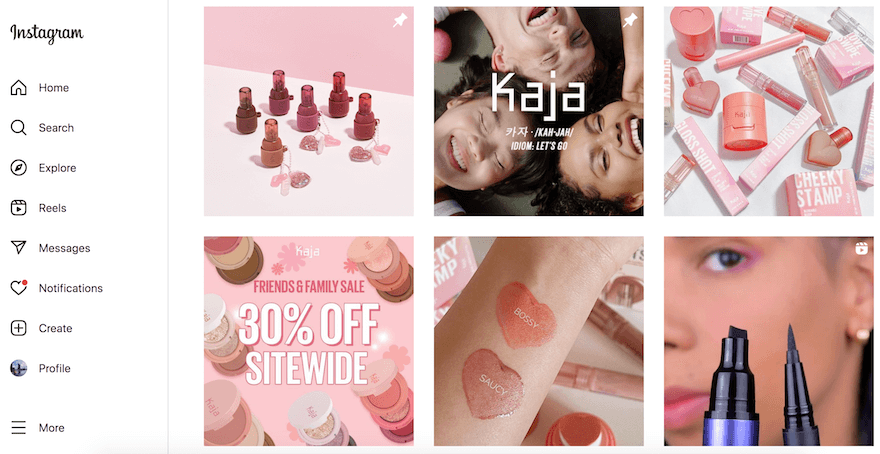Top 6 Trends in Social Commerce: Industry Insights
If you click to purchase a product or service based on our independent recommendations and impartial reviews, we may receive a commission. Learn more
Thought social media was just about liking, commenting, and sharing? About humorous cat filters, and DIY dance videos?
Think again. Because social media isn’t only about socializing anymore. But selling.
According to Influencer Marketing Hub, this year global social commerce sales are expected to hit almost $1.3 billion*. But if your business wants a slice of that sweet social pie today, you need to first get to grips with tomorrow – more specifically, with a social media strategy that factors in the social commerce trends currently driving the industry.
So what is social commerce, exactly? How does it differ from ecommerce, why should you be interested in it, and – most importantly – what are the top 6 social commerce trends you need to know about?
Let’s take a look.
What Is Social Commerce?
Social commerce is when you use social media platforms – think Facebook, Instagram, Twitter, and Pinterest – to sell online.
It’s when your customers browse and buy your products, all directly through your social media channels. Social commerce can take the form of:
- Shoppable posts: images or videos of your products which contain a link to buy them
- Live streams: enabling you to showcase, and ask questions about, your products and services in real time
- Social media marketplaces: allowing you to set up an online storefront within a social media platform – making it simple for customers to find, and purchase, your wares
What’s the Difference Between Social Commerce and Ecommerce?
While both social commerce and ecommerce have some similarities (they both relate to online shopping, for instance; that’s the commerce part of the name!) there are some key differences.
Ecommerce, as an umbrella term, refers to any commercial transaction made over the internet. In an ecommerce sale, you sell to your customer through an online store (this could be your own website, built using an ecommerce website builder, or through an existing marketplace, such as Amazon, Etsy, or eBay).
Social commerce is any selling done online through social media platforms specifically. In a social commerce transaction, your customer can peruse, purchase, and pay for your product – all while never having to leave the social platform you’re selling through.
The Benefits of Social Commerce
So – is social commerce right for your online business? Here are just a handful of the benefits:
- More sales: social commerce is a simple, seamless way to sell – and, by expanding your sales channels out to multiple social media platforms, you’re widening your reach and potential customer base.
- More brand exposure: social media platforms are used by huge amounts of people, every day (Instagram alone has over 2 billion daily users), so they’re an excellent way to spread the word about your brand and products.
- More engaged customers: when you interact with (read: sell to!) your customers through social media – a place they spent a lot of time, amongst friends – it allows you to do so in a more personalized way. And build stronger relationships.
- More conversions: because your customers never have to leave the social platform they’re on to make a purchase, there’s little friction – which can do wonders for your conversion rates!
- More insights into customer behavior: with social commerce, the platforms you’re selling through offer advanced, in-depth analytics into your customers’ behavior and preferences – allowing you to better tailor your marketing and catalog going forward.
6 Social Commerce Trends
From AR to AI to NFTs and beyond, let’s unpack this year’s social commerce trends – and what they mean for your business.
AR Experiences Become Commonplace
Augmented reality (AR) in ecommerce is already very much a thing. But its popularity in social commerce is rapidly on the rise, too. Over 16% of people in the US already use AR on social media – and, by 2025, that figure is expected to be almost 20%.
AR is a type of tech that enhances the world around your customer – superimposing a layer of computer-generated imagery over the top of what’s already there.
Social media platforms have, of course, been cashing in on AR tech for a long time. Every time you use a Snapchat filter to add bunny ears to your temples, or superimpose a dog’s nose and lolling tongue over your face, you’ve used AR.
But more recently, more commercial uses of AR have taken shape. Brands like L’Oreal, for instance, have been using AR for some time to allow shoppers to “try on” different shades of lipstick – without ever going near the actual makeup itself.
Recently, L’Oreal teamed up with Facebook to bring this AR experience to Instagram – and we can only expect this social commerce trend to keep gathering pace.

AI-Trained Chatbots
These days, customers don’t just want to be sold to. They want to be listened to. They want to be able to start up a conversation with your business, and be spoken to in a way that feels authentic; that resonates as congruent with your brand’s identity and image.
That’s why the live chat features on social media platforms – a place where customers can reach out and start up a dialog with your brand in seconds – are so popular. But of course, running a live chat service (especially one available 24/7, as most consumers demand) is time-consuming and expensive. And for many small businesses, it’s downright impossible.
What this means is that AI-trained chatbots – tools capable of replicating a human-led live chat feature, but that don’t require sleep or food – will only grow in popularity as one of the top social commerce trends of this year.
As the AI underpinning these chatbots’ algorithms becomes more advanced, the better these conversational commerce tools will become at understanding customer requests, and answering their queries, through social media. So watch this space!
Micro-Influencers Will Help Brands Grow Online
According to Influencer Marketing Hub, “micro-influencers” are those with between 10,000 and 50,000 followers. (For a full rundown on the four major tiers of influencers, check out our guide to micro, macro, nano, and mega influencers.)
As the name suggests, micro-influencers don’t have the largest numbers of followers to their names. What they do tend to have, however, are more loyal, engaged follower bases. More perceived transparency and authenticity. And highly specific, targeted niches to tap into.
The other thing micro-influencers have going for them? They tend to come cheaper than their macro and mega counterparts. That means that, for brands looking to use influencer marketing to widen their reach on social media platforms – but on a shoestring budget – micro-influencers provide an accessible, affordable way of doing so.
Find Out More
- Micro-Influencers on Instagram: Who Are They and How to Find Them?
- TikTok Micro-Influencers: How They Can Help Grow Your Brand
Visual Shopfronts on Instagram
One brand making particular headway into serving up seamless social commerce experiences is Instagram.
Its visual shopfronts allow your business to create an engaging storefront experience for your customers – all from within the app. You can show off your products in an immersive, interactive way by featuring them in curated collections or catalogs.
Why Instagram’s visual shopfronts are such a game changer is that you can turn any media on the social app – be it a photo or a video – into a sellable product. All while keeping your customer on the platform to avoid friction.
While Instagram’s visual shopfronts aren’t being used by all brands right now, their user-friendliness and aesthetic appeal mean they’re growing in popularity – and will remain one of the top social commerce trends to look out for.

NFTs Become Mainstream
NFTs (Non-Fungible Tokens) are digital assets which represent ownership and authenticity of a unique piece of content. NFT buyers and sellers utilize blockchain technology to exchange them on online marketplaces – so it’s only natural that they’d soon make their way into the social commerce domain.
In 2022, Mark Zuckerberg’s Meta waded into the world of NFT – sharing the digital assets, and selling trials on Instagram and Facebook to a subset of users in the US. Yet, while NFTs are making their slow way into the mainstream, concerns around their volatility, unreliability, and lack of regulation remain.
So, while it could be something your brand looks to incorporate as part of its social commerce strategy going forward, we recommend proceeding with some caution.

Social Polls and Quizzes to Collect Data
With customer data safeguarding laws across the globe tightening, consumers now have more awareness around – and protection of – their data rights. Skepticism around third-party cookies has never been higher – and for brands, that means they’ll need further, more innovative ways of collecting customer data.
Enter: social polls and quizzes. Social media has long been known as a place where people are willing to interact with brands – particularly if it’s in an immersive and engaging way, or one that gives something back. Through polls and quizzes, brands can do this – while also making use of their customers’ responses to help them personalize their product offerings.
With rules and regulations forever evolving – and the pace of technology swiftly quickening to meet it – brands will have to find new ways of procuring the data they need. Polls and quizzes are just one of these social commerce trends we’ll be seeing more of this year – and beyond – as more brands make them a key part of their social media strategies.

Summary
If you’re looking to sell online, we always recommend setting up your own online store – whether that’s with a CMS (Content Management System) or website builder – and selling through that. However, making money through social media is always an appetizing prospect – and social commerce is an excellent way of diversifying your sales channels, and exposing your products and brand to a much wider audience.
To that end, it’s important to know what you’re getting into in the social media selling game – which means staying abreast of the key social commerce trends of the future.
These, again, are:
- AR experiences becoming commonplace
- The rise of AI chatbots
- Micro-influencers helping brands grow online
- Instagram visual shopfronts gaining pace
- NFTs becoming commonplace
- Brands relying more on social polls and quizzes to collect customer data
Thought of a social commerce trend we’ve missed? Let us know in the comments – and drop us a line with your thoughts on this article while you’re at it!
Leave a comment